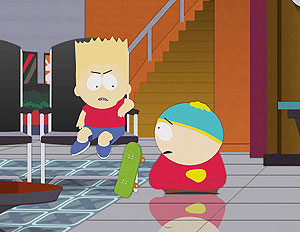Oh Hamburgers: Thoughts On South Park‘s 15-Year Run
Published on July 30th, 2011 in: Cartoons, Comedy, Issues, My Dream Is On The Screen, TV |By Ben Sullivan
Few serialized forms of entertainment—let alone television shows—have been so defined by an overt enthusiasm to piss off all elements of their viewing audience as South Park. Presaging the Adult Swim grotesque and Seth McFarland’s ribald flippancy, South Park tossed its cavalier line into every cultural imbroglio, national hypocrisy, or simple question of taste at hand. From paparazzi to PETA to NAMBLA, from hybrid drivers to iPad users to country music listeners, from liberals to conservatives to just about any A, B, or C-list celeb caught in the compromises of fame and exposure, South Park‘s defamatory fangs have never wanted for fresh meat.

Reluctantly passing the torch . . .
even if they both agree on Family Guy.
Not to say that it’s all been lampoon and pillory. The show’s fourth episode, “Big Gay Al’s Big Gay Boat Ride”—written prior to Comedy Central picking up the remainder of the first season in 1997—saw Trey Parker and Matt Stone take a more permissive, cautiously progressive stance on homosexual representation than many leading politicians would dare venture today. This brand of hot-button daring, water-cooler (and cafeteria-table) baiting topicality was both Comedy Central’s ticket to cable preeminence, and the drawing board for the mainstream approbation now being heaped on Parker and Stone’s Tony Award-winning Broadway show Book of Mormon.
Throughout the last 15 years, South Park has steered a uniquely resilient course in the transgressive purview of “Adult Animation.” Parker and Stone eschew The Simpsons‘ retrenchments in arch storytelling and sitcom formula by calling attention to the sheer unbelievability and sloppiness of their plotting; sublimate and repurpose Beavis and Butthead‘s intellectual anemia into the absurdity of events, everyday and monumental; further articulate the polymorphous perversions of Ren and Stimpy (the Lemiwinks saga, anyone?); and generally get away with railing against convention, all the while reveling in the nuts and bolts of successful entertainment. Their radical, at-least-the-writer’s-laughing approach is perhaps best echoed by the truly volatile Tim and Eric: Awesome Show Great Job! Very few shows after South Park have had equal parts conviction and bad taste.
I tuned in to the first season of South Park having videotaped the first four seasons of The Simpsons with my mom’s assistance. Like much of the show’s initial audience, I viewed Parker and Stone’s sense of humor (and occasional malice) as a response to Groening and co.’s quality writing, internal logic, and creeping predictability. South Park‘s worldview, voiced by children and impossibly incapable adults, was instead communicated in upended flashback discontinuity, self-consciously marketable catchphrases (“They killed Kenny!” on down the line), parody and self-parody, disasters (the Internet’s dried up!) and bad guys (the defrocked and obliteratingly emasculated cut-outs of Saddam and bin Laden, reduced to Satan’s incorrigible ex and a Looney Tunes clown), and regular third act deus ex machina wrap-ups.
Episodes regularly meandered through ideas bad enough to seem experimental in their refusal to entertain. And as opposed to the family affirmations offered at the end of classic Simpsons eps, South Park‘s students, who never failed to, you know, “learn something today,” offered moral lessons that were often undercut by the violence or incongruity of their enclosing narratives.
And be it as it may—a rite-of-passage, a banal mile marker, or a modern index of the ways in which our generation begrudgingly grows up—most of us reading and writing about cartoons like South Park have gone from identifying with Bart and Lisa to sympathizing with Homer, Marge, or the ageless Ned Flanders. But stranger yet is the long day’s journey from the 18-year-old-and-under end of South Park‘s target demographic to its 34-year-old sunset, a journey marked less by the accommodations of self-knowledge and budding seriousness than by a shirking self-reflexivity, an exercised need for commentary on every byline (to say nothing of the comment fields now metastasizing and bellowing beneath every blog post and status update).
South Park anticipates and reflects today’s Internet-driven 24/7 news cycle. Parker and Stone’s computerized cardboard cut-out world has been able to shave its usual three-week episode production cycle down to four days in the event of Terry Schiavo’s death (and once, under 24 hours in order to incorporate parts of Obama’s victory speech the day after his win). However, the show’s incredible turnaround and topical flexibility might be at the expense of a certain . . . editorial disposition. It feels as if Parker’s adherence to his now-fourth-grade principal characters in all their pre-pubescent vulgarity must occasionally lead to the worst idea winning out. Funny in principle; in practice, it’s now the same litany of fart jokes, Cartman vitriol, and unnecessary violence that will only connect with the recent teenaged converts.
So what do we take away from the 216 (and counting) episodes? What follows are a few thoughts on South Park‘s legacy and defining characteristics in light of its strongest episodes.
Time limit is exhausted. Please reload the CAPTCHA.